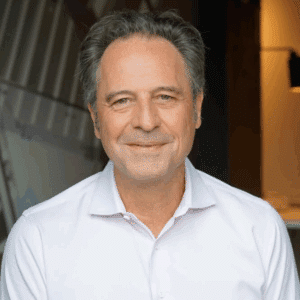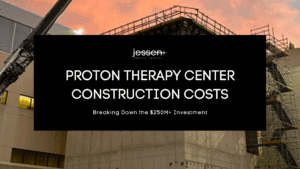Building a proton therapy center is one of the most complex undertakings in the healthcare industry. It’s a $250+ million investment that requires specialized expertise that extends far beyond just architecture and construction.
Proton centers aren’t just buildings that hold machines—they are the machines themselves, demanding the precision of an instrument, not just the construction of a building. These facilities are 1,000 times more complex than a LINAC (linear accelerator) center. The difference between project success and costly delays often comes down to one critical factor: assembling the right team with proven proton therapy project management experience.
We have 40 years of architectural experience at Jessen Proton Therapy, and we’ve guided dozens of institutions through this intricate process, from initial feasibility studies to celebrating that milestone moment of first patient treatment. Our approach recognizes a fundamental truth that many discover too late: “it depends” is the most honest answer to almost every proton therapy planning question, which is why specialized expertise matters.
Let’s break down not only what every proton therapy project needs, but also where Jessen Proton Therapy can step in to support your project.
Four Distinct Service Models for Complex Projects
Every proton therapy center project demands different levels of support, which is why offer four service models that can adapt to your needs and existing team capabilities.
Full Service Architecture Services
As the architect of record, we lead the entire project from concept through completion, coordinating specialized teams, managing complex timelines, and ensuring every technical and operational requirement is met. We can provide full services or custom design the experience based on your needs.
Our team manages everything from initial site analysis through construction administration, coordinating the complex interplay between equipment manufacturers, shielding consultants, and specialized contractors. This full-service model works best for institutions embarking on their first proton therapy center or those requiring complete project leadership.
We can also step in for front-end planning and master planning before a technical architect takes over, or partner with local architects who may have better knowledge of permitting requirements. When we form teams with local architects, we ensure it feels like one unified team to the client.
Proton Therapy Center Project Management
Many talented local architects excel at healthcare design but lack the specialized knowledge required for proton therapy centers. In these cases, we serve as the proton therapy expert, guiding the local design team through the unique challenges these facilities present. We offer comprehensive “soup-to-nuts” project management, from pre-design through construction, commissioning, and all the way to first patient treatment.
This project management role extends far beyond traditional construction oversight. We shepherd projects through the entire 3-5 year timeline—from equipment selection and installation through clinical commissioning to first patient treatment. Not all architects understand that their role doesn’t end when construction is complete, but we do.
Subject Matter Expert Advisory
Sometimes institutions need our expertise at the decision-making table without full project management. This model works when a project already has a project manager (usually from existing staff) but needs proton therapy expertise. It’s more limited in capacity than full project management, with a more focused scope and time commitment. As subject matter experts, we walk in lockstep with ownership teams from the very beginning, providing advisory guidance throughout the project’s lifespan.
We’re currently working in this capacity with a university that has assigned us as their proton therapy advisor. Their existing team knows the campus well but lacks proton therapy knowledge. They had already selected their architect, contractor, and project management team, then added Jessen in an SME advisory role. We participate in all calls and answer questions as they arise—providing exactly the type of specialized knowledge that is needed, at a minimum, for any proton therapy project.
This advisory role proved essential with Baptist Health Miami Cancer Institute’s proton therapy center project, where we joined at the eleventh hour. The team faced a challenging question: “What do we need to do to add protons to an existing cancer center already in permitting?” Through intensive work sessions, we quickly determined how to integrate proton bunkers into the pre-planned building—ensuring the proton therapy center wasn’t just an appendage but a seamlessly integrated component of the larger facility.
The result became South Florida’s first proton therapy center and the only cancer center worldwide offering all the latest radiation therapy technologies in one building. Since 2017, Baptist Health has treated over 2,500 patients with its proton therapy program, making it the first U.S. center to pair the latest-generation proton delivery platform with pencil beam scanning. The 40,000 square foot proton center occupies the first floor of the 4-story, 450,000 square foot cancer center, and showcases how late-stage support can take an important project across the finish line.
Owner Representation
We can also sit on the owner’s side of the table to guide them through the entire process. In this role, we help bring in the right consultants at the right time, ensuring the owner’s interests are protected and the project stays on track.
Our design services are completely customizable to match your organization’s needs and existing capabilities.
Additional Specialized Services
Feasibility Studies
Before committing to a proton therapy center, we help clients start to define their center through comprehensive feasibility studies. These studies evaluate whether a project is feasible for your budget, schedule, site, and patient volume.
We’ve conducted dozens of these studies—sometimes they lead to projects being implemented, and sometimes they lead to projects not happening (which can be equally valuable information).
Why should someone do a feasibility study? Start with big picture costs and considerations, study your specific site, and then expand into more detailed analysis as you progress. This stepped approach helps organizations make informed decisions about a potentially significant investment.
Decommissioning and Upgrades
The Massachusetts General Hospital upgrade stands as our most challenging project ever—and the first major proton equipment upgrade in history. This was essentially a reverse engineering project, requiring us to make the old space ready for a new system. There’s no guarantee the new equipment footprint will match the old footprint, which became even more challenging with the facility under a tower.
This type of work is completely new to anyone working on proton therapy projects. Interestingly, while equipment has actually gotten more expensive over time, buildings have gotten smaller—a trend that creates both opportunities and challenges for upgrades.
Understanding the Proton Therapy Center Project Timeline
The complexity of proton therapy centers demands realistic timeline expectations. Our best-case scenario from project initiation to first patient treatment spans two years and nine months, but most projects require at least three to five years. For reference, our longest project to date took five years from design to first patient treatment.
Major Project Phases
Planning and Programming (6-12 months): This phase determines what you want in your center—pediatric capabilities, research facilities, specific treatment modalities—through structured work sessions that establish the foundation for everything that follows.
Design and Documentation (6-12 months): The formal design process involves assembling specialized teams and creating comprehensive documentation. We utilize Building Information Modeling (BIM) technology, allowing up to 30-40 team members to work simultaneously in live 3D models rather than in 2D drawings. This collaborative approach eliminates hand-offs and enables real-time coordination between disciplines.
Construction (12-18 months): Building the massive concrete vaults requires at least 12 months, though timelines can be expedited. Clinic construction proceeds more quickly because it requires less specialization.
Equipment Installation and Commissioning (12-18 months): Installing and calibrating proton therapy equipment is one of the most complex phases. Equipment must be loaded from the top down, requiring pre-planned crane placement and access routes. We work through extensive checklists with proton vendors to ensure proper sequencing and avoid costly delays.
Clinical Commissioning (Up to 4 months): The final phase involves clinical team training, treatment planning system verification, and regulatory approvals before treating the first patient.
Site-Specific Considerations
Every proton therapy site presents challenges that significantly impact project timelines and costs. Groundwater levels, bedrock conditions, site slopes, and proximity to existing buildings all create variables that must be addressed during planning.
Equipment access planning is one of the most critical—and frequently overlooked—aspects of site development. Equipment must physically enter the building during construction and be extractable decades later for upgrades or replacement. We learned this lesson firsthand during the Massachusetts General Hospital upgrade, the first major proton equipment upgrade in history, where subsequent construction above the proton center complicated equipment extraction.
The Miami project exemplified how site constraints can create engineering challenges. Adding proton bunkers to an in-progress cancer center required innovative solutions that integrated massive shielding requirements with existing structural systems—work that demanded specialized proton therapy expertise to execute successfully.
Assembling Your Proton Therapy Team
Successful proton therapy projects require a carefully assembled team of specialists who understand the demands these facilities present. The complexity multiplies other healthcare construction challenges by a factor of one thousand, making relevant experience essential for every team member.
Key Team Members
Owner and Project Champion: Every successful project requires a dedicated champion who can navigate institutional decision-making and maintain momentum through the lengthy development timeline.
Architect and Design Team: The architect serves as the ring leader of the design team, coordinating between multiple engineering disciplines and specialized consultants. Proton therapy experience is crucial, as these projects differ fundamentally from other healthcare facilities.
Specialized Engineers: Structural, mechanical, electrical, and civil engineers must all understand proton therapy requirements. Any other level of healthcare engineering experience doesn’t translate directly to proton therapy centers.
Shielding Consultant: Typically a medical physicist, the shielding consultant designs the massive concrete barriers required for radiation containment. This expertise is unique to particle therapy facilities.
Construction Manager and Contractors: Construction teams must understand the sequencing requirements, equipment access needs, and specialized installation processes that define proton therapy construction.
The Global Coordination Challenge
Many proton therapy projects involve teams spread across multiple locations and time zones. We’ve managed complex coordination like Mayo Clinic’s simultaneous Rochester, Minnesota, and Phoenix, Arizona centers, proving that specialized project management expertise makes multi-site projects possible.
Our experience spans domestic and international projects, from the University of Texas Southwest to SAH Muscat Oman, SAH Qatar, and SAH Bahrain. Each project presents logistical challenges that require specialized proton therapy project management expertise across different cultural and regulatory environments.
Why Healthcare Experience Isn’t Enough
The most common—and costly—mistake institutions make is assuming that healthcare construction expertise translates to proton therapy projects. These centers are 1,000 times more complex than LINAC facilities. Proton therapy centers require fundamentally different planning considerations than any other facility in healthcare and beyond.
We encountered this misconception firsthand during a Milwaukee project originally designed using LINAC precedents. The team had designed the facility on stilts, similar to standard radiation facilities. When we joined the project, we immediately identified the critical flaw: proton therapy equipment weighs far more than anticipated. The entire structure required demolition and rebuilding from the foundation up.
Equipment differences alone highlight why specialized expertise matters. Consider something as seemingly simple as doors—proton therapy centers operated without doors entirely for years due to stringent radiation containment requirements. We pioneered the development of specialized proton-compatible shielded sliding doors, an innovation that transformed how these facilities can be designed and operated.
The Technology Integration Challenge
Proton therapy centers require precise integration of medical physics equipment with architectural solutions. Every building system must be designed specifically for proton therapy, with little opportunity to use standard healthcare design.
More compact equipment has revolutionized space efficiency, reducing facility footprints by 50%. However, this miniaturization hasn’t reduced complexity—it has concentrated it, requiring even more precise coordination between architectural and equipment teams. And, as we mentioned earlier, while equipment has actually gotten more expensive, buildings have gotten smaller, creating new design opportunities and challenges.
The BIM modeling approach we employ enables unprecedented coordination between disciplines. Our live 3D models serve as the single source of truth for all project team members, eliminating the communication gaps that often plague complex construction projects.
Success Through Specialized Expertise
The difference between successful proton therapy projects and those that encounter costly delays typically comes down to team expertise and realistic planning. We’ve seen projects succeed brilliantly when approached with appropriate specialized knowledge.
The highest priority for every project remains the same: achieving first patient treatment as quickly and cost-effectively as possible. This focus drives every decision we make, from equipment selection to final commissioning, and everything in between.
The Human Impact
Behind the technical complexity and massive budgets lies the real reason we pursue this challenging work: knowing that patients are receiving more precise treatment with fewer side effects because of these centers. They are quite literally saving lives, families, and futures.
Every proton therapy center gives hope to thousands of patients who will receive less invasive, more precise treatment. The complexity is worth the human impact. We are proud to be a small part of advancing cancer care.
Next Steps
The question isn’t whether you need specialized help—it’s determining which level of support best serves your project.
Whether you need full-service architecture, comprehensive project management, subject matter expert guidance, or owner representation, our 40 years of experience and dozens of completed proton therapy projects worldwide will ensure a strong foundation.
The complexity of proton therapy centers means that seemingly small decisions during early planning phases can have enormous impacts on costs, timelines, and operational efficiency. Getting it right from the beginning requires the right expertise at the right time.
Contact Jessen Proton Therapy to discuss how we can guide your project from vision to first patient treatment, ensuring your investment delivers the clinical and operational success your institution—and future patients—deserve.





